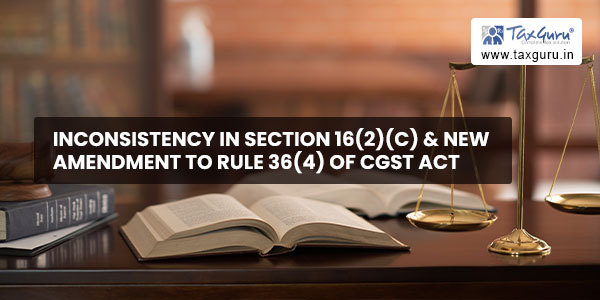Input tax credit means credit of ‘input tax’- Section 2(56) of the CGST Act, 2017.
Input Tax Credit is the core concept of GST as GST is destination based tax. There are certain anomalies between the act and the rule which are creating practical problems in availing ITC.
Input tax credit means credit of ‘input tax’- Section 2(56) of the CGST Act
As per section 155 of the GST act- Where any person claims that he is eligible for input tax credit under this Act, the burden of proving such claim shall lie on such person.For claiming ITC, the taxpayer has to meet some basic eligibility and conditions which are prescribed under CGST Act and Rules.
SECTION 16(2)(c)
(2) Notwithstanding anything contained in this section, no registered person shall be entitled to the credit of any input tax in respect of any supply of goods or services or both to him unless,––
(c) subject to the provisions of section 41 or section 43A,the tax charged in respect of such supply has been actually paid to the Government, either in cash or through utilisation of input tax credit admissible in respect of the said supply; and
This section states that a recipient’s right to ITC is conditional on the supplier paying tax, either in cash or through the use of utilisation of admissible ITC, on the supply in question; otherwise, the recipient will not be able to claim ITC on his purchases
RULE 36(4)
Rule 36 – Documentary requirements and conditions for claiming input tax credit
(4) Input tax credit to be availed by a registered person in respect of invoices or debit notes, the details of which have not been uploaded by the suppliers under sub-section (1) of section 37, shall not exceed 20 per cent. of the eligible credit available in respect of invoices or debit notes the details of which have been uploaded by the suppliers under sub-section (1) of section 37.”
This rule was made and amended vide the following notifications
- Central Tax Notification No. 39/2018 (dated 04th September 2018)
- Central Tax Notification No. 49/2019 (dated 09th October 2019)
- Central Tax Notification No. 75/2019 (dated 26th December 2019)
- Central Tax Notification No. 30/2020 (dated 03rd April 2020)
This Sub-Rule was amended several times to put restrictions on availability of eligible ITC to the purchaser from 20% to 10% and then to 5%. Now Rule 36(4), which allowed for ITC up to 5% over the applicable ITC for which the details are given by the vendors in GSTR 1, has been amended with effect from January 1, 2022, to remove the 5% benefit.
The amended regulation states that no ITC can be claimed for an invoice/debit note unless.
(a) details of such invoice/debit note have been furnished in GSTR 1 or IFF and
(b) such details have been communicated in GSTR 2B.
From January 1, 2022, the ITC for an invoice/debit note can only be claimed if the details of the invoice/debit note are reflected in GSTR 2B. It may be noted that the said condition does not apply to availability of ITC in respect of imports/RCM (unregistered vendor)/ISD.

Indirectly burdening the buyer to prove that tax has been actually paid to the government by the seller.Following this adjustment, taxpayers are only authorised to claim ITC that is recorded on GSTR 2B.
There are plenty of questions that pops up in the mind of the recipient on availment of ITC which is hit by a inconsistency of Section 16(2)(b) and Rule 36(4)
- Do I have any legal authority to ensure the seller’s compliance?
- Is it possible for me to sue the vendor for not paying the tax and receive speedy justice?
- Is it possible for me to play the role of a law enforcement agency?
- Is it possible for a poor buyer like me to compel the seller to pay the tax only if he can show me that he has already paid it to the government?
- Is there any method in place, established or regulated by the government, through which I may determine if the vendor has paid the tax?
- How do I further confirm the GSTR-3B figures include supplies made to me?
- I can see his return filing status, but how do I know whether the amounts on the GSTR-3B and the taxes paid are the same as on the GSTR-1?
Let us understand with an example:
A (SUPPLIER) made a supply to B (PURCHASER) in the Month of January 2022. B(Purchaser) received the material also in January 2022 and booked in his accounts. A(supplier) has filed his GSTR1 for the month of January 2022 on or before 11th February 2022 But the (supplier) A has failed to file his GSTR- 3B return for the month of January 2022.
Now we will analyse this situation from the purchaser point of view keeping in mind the Section 16(2)(c) and Rule 36(4)
- When the (Supplier) A has filed its GSTR-1 it will be shown in the GSTR-2B of the purchaser. Whether this is an eligible Credit for B (Purchaser) as it is reflected in his GSTR 2B?
Technically yes, the (purchaser) B is liable for the ITC when it is reflected in his GSTR 2B January 2022 return
- Whether the (purchaser) B can claim this ITC in his GSTR3B for the month of January 2021?
Logically Yes, he can claim ITC because supply by the supplier is shown in his GSTR 2B return so he is entitled to take ITC .But as per section 16(2)(c) he is not eligible because the supplier has failed to file the GSTR 3B return.
Here comes the inconsistency between the section 16(2)(c) and Rule 36(4)
In the above situation when the (purchaser) B complies with the requirements set out in section 16(2)(c) and does not claim ITC because his supplier has not paid the tax to the government, accordingly he is liable to claim ITC of the previous month in the succeeding month when his supplier pays the tax to the government.
Now, the rule 36(4) came into play and states that the recipient is liable to take ITC, that is only reflected on the GSTR 2B as per 10th amendment to CGST Rules. In Form GSTR-2B, the details of inward supplies will be reflected in a static manner. It will only reflect the details of outward supplies that is reflected by the supplier between two due dates of either Form GSTR-1 or Invoice Furnishing Facility.As a consequence, the data shown in the GSTR 2B of the following month will not contain the previous month data uploaded by the supplier. As a result of this rule, the taxpayer is denied the ITC that he has voluntarily left since the supplier has not completed the conditions of 16(2)(C).
Eligibility and conditions for taking input tax credit under Section 16(4) of CGST Act
“A registered person shall not be entitled to take input tax credit in respect of any invoice or debit note for supply of goods or services or both after the due date of furnishing of the return under section 39 for the month of September following the end of financial year to which such invoice or invoice relating to such debit note pertains or furnishing of the relevant annual return, whichever is earlier”
Now as per Section 16(4), a Recipient is allowed to avail Input Tax Credit for the Invoices issued by his supplier in a Financial year, till September month of Subsequent Financial year. As a result the purchaser in this case is liable to take the ITC till the September month of the Subsequent Financial year.The delay in availing Credit could be of various reasons which include quality approval of received material, accounting delays, approvals etc., So the GST Act allowed the Recipient to avail the Credit at a later date also but not after September of the Subsequent Financial Year.
Conclusion
Government intention behind taking the above-mentioned steps on restricting the quantum of input tax credit by rule 36(4) or claim of the input tax credit on the basis of GSTR 2A by insertion of new clause (aa) under section 16, is to curb the practice of claim of the input tax credit through fake invoices, which is highly appreciated and really the need of the hour. But putting the entire burden on a buyer without providing them any facility to cross-check whether the supplier has paid the tax or not is unjustified and creating undue hardships to the bonafide buyer who has received goods or services, paid the tax to the seller and having possession of valid document to claim ITC.
The Assessee should be able to claim ITC for the documents in his possession, and his purchase record should be submitted to the GST portal in invoice-by-invoice detail, similar to how sales are reported in GSTR1. The department can use this Purchase Register report to do the same reconciliation as before to identify defaulting Suppliers and take appropriate action against them, such as recovery or blocking their future transactions. The Rule 36(4) criteria must be waived until the original intention of Supplier Invoices appearing on the Recipient GST dashboard and the Recipient being able to take action on each Invoice is fulfilled.
REFERENCES
1. https://taxguru.in/goods-and-service-tax/sec-16-2-c-cgst-act-2017-a-nightmare-taxpayers.html






can u plz guide. my purchase invoice is of jan 2022 and sale invoice is jan 2022 as well. i paid tax for sale i made for jan returns. now seller has filed returns for jan, which reflects on my gstr2 on 20th feb. so my question is how will i claim itc and will it reflect and populate automatically in feb returns or not?